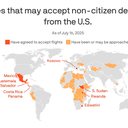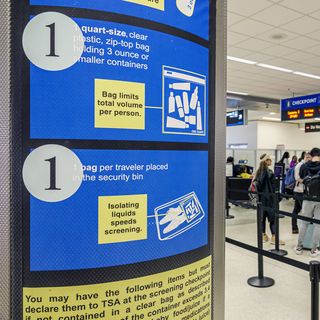Normal view
Report: Lakers Looking to Pair Luka Doncic With Nikola Jokic
Bean Recall Sparks Nationwide Warning to Customers
Some businesses have held off on hiking prices, but this might not last for long

Jeenah Moon/REUTERS
- Consumer prices have not risen as much as expected, but this may change soon.
- The Federal Reserve's Beige Book warns of price hikes as tariffs become entrenched.
- Businesses are reporting rising costs overall, with some sacrificing profit margins for tariffs.
Prices have not gone up as much as expected for consumers, but this might not last for long.
The latest Federal Reserve Board Beige Book, a publication that provides general information about the current state of the economy, mentioned tariffs 75 times and warns of price hikes as tariffs become more entrenched.
Across all 12 Federal Reserve districts, businesses told the Federal Reserve that tariffs have increased their costs either modestly or pronouncedly. Many manufacturers reported being surcharged by their suppliers, especially for raw materials used in manufacturing and construction.
While many businesses said they passed along costs to consumers through price hikes, others held off due to price-sensitive consumers, which affected their profit margins.
For instance, a manufacturing company in Memphis told the St. Louis Federal Reserve that it had raised prices significantly to offset the tariff cost on steel and aluminum, but a packaging company in the district is swallowing at least 10% in surcharge due to competition with larger manufacturers.
But the prices may not stay low for long as tariffs prolong.
"Contacts in a wide range of industries expected cost pressures to remain elevated in the coming months, increasing the likelihood that consumer prices will start to rise more rapidly by late summer," wrote the Federal Reserve System in the July Beige Book.
"It seems that prices have gone up out of fear that prices will go up," a construction materials supplier told the Federal Reserve.
The consumer price index, a broad-based measure of goods and services costs, shows that prices have not skyrocketed post-tariffs. In June, prices inched up by 0.3%, putting the 12-month inflation rate at 2.7%. This is mostly in line with analyst expectations, though it's still above the Federal Reserve's goal of 2%.
The Trump administration recently sent tariff letters to nearly two dozen trading partners, threatening duties as high as 50% starting from August 1. None of the four existing trade agreements with the UK, China, Vietnam, and Indonesia has yielded tariffs below 10%, suggesting that the baseline tariff imposed on April 2 may be here to stay.
Michigan Wolverines, Sherrone Moore Pick Up Huge Recruiting Flip
NFL Analyst Sounds Off on Recent Reveal for Eagles' Jalen Hurts
-
Latest News
- New York's tech elite give Mamdani points for 'charisma' — and engaging with them at closed-door meet
New York's tech elite give Mamdani points for 'charisma' — and engaging with them at closed-door meet

Don Eim
- New York City mayoral candidate Zohran Mamdani tried to woo the city's tech denizens on Wednesday.
- He engaged in a fireside chat attended by roughly 200 startup founders and venture capitalists.
- In the discussion, Mamdani seemed to balance progressive ideas with pragmatic outreach.
Zohran Mamdani had no deck, but plenty of pitch when he met with New York City's tech community on Wednesday night.
At an invite-only fireside chat with venture capitalist Kevin Ryan, the New York City Democratic mayoral candidate tried to sell a room of tech workers and startup investors on his vision for a city that works for the working class.
And he mostly avoided the controversy surrounding his views on Israel and tax hikes for the city's millionaires and billionaires, according to multiple people who attended the event.
Fresh off a primary win powered by the blunt message that New York is too expensive, Mamdani spent about an hour taking questions from New York's tech workers at an event hosted by the Partnership for New York City, Tech:NYC, and AlleyCorp, Ryan's venture capital firm that incubates and invests in startups.
The crowd of some 200 people included startup founders, angel investors, and general partners from venture capital funds.
The event, held at a gleaming skyscraper in Midtown, offered a stark contrast to the candidate's grassroots campaign, which was built around free city buses, a freeze on New York rents, and tax hikes for millionaires. Mamdani leaned in, fielding questions with a mix of what attendees who spoke to Business Insider characterized as "charisma" and pragmatism.
Ryan told Business Insider that when someone in the audience raised President Donald Trump's social media post about Mamdani, which referred to him as "a 100% Communist Lunatic" who "looks TERRIBLE," he joked that it must have hurt Mamdani to hear he looked lousy, drawing scattered laughs.
During their discussion, Mamdani and Ryan pinballed from the state of affairs in New York's tech scene to initiatives across housing, childcare, transportation, healthcare, and government efficiency, attendees said.
Last week, Mamdani collided with tech's more conservative wing on social media after a Sequoia Capital investor's viral comments referring to the candidate as an "Islamist."
Ryan said the post didn't come up during the chat, but one audience member did ask Mamdani about his past comments on Israel. Mamdani deflected, Ryan said.
"He was trying to focus on being mayor of New York," Ryan said, "not mayor of the Middle East."

Don Eim
Mamdani was somewhat vague, Ryan and other attendees said, when asked about his previous comments about billionaires. "I don't think that we should have billionaires because, frankly, it is so much money in a moment of such inequality," Mamdani said in a TV interview in June.
He seemed to be reaching out to the business community, nonetheless.
"He didn't have to meet with the CEOs," said Ryan, referring to a Tuesday meeting with New York's business leaders.
In that meeting, Mamdani reportedly said that he would not use the phrase "globalize the intifada" and that he would "discourage" others from doing so, after months of declining to condemn the phrase that some interpret as a call to violence against the Jewish people.
At Wednesday's event, one attendee, who works at an artificial intelligence company, said he saw the candidate's rhetoric soften into a more pragmatic approach. The person said that when someone asked Mamdani what he hoped to achieve in his first hundred days in office, the candidate referenced a 2009 proposal by then-Mayor Michael Bloomberg to make cross-town buses free. Mamdani has said that he plans to make every bus in New York free.
"I was glad to see him being open to new ideas and working with people outside his base," said Yoni Rechtman, a Brooklyn venture capitalist who attended the event. "Over the last few months, he's done a good job moderating on issues that matter to New York." Rechtman questioned if that was because of "an authentic commitment to pragmatism" or "just typical politicking."
"He's engaging," Ryan said, "even though he knows that many people in the room don't agree with a number of his positions. I will give him credit for reaching out."
As an organizer, Ryan played both host and ambassador. He's among the early architects of New York's startup scene, the original "Silicon Alley insider." His hands were on many of its flagship tech companies: Gilt Groupe, MongoDB, and even Business Insider, which he started along with Henry Blodget and Dwight Merriman in 2007.
Ryan, who has previously cohosted events with Mamdani rivals Mayor Eric Adams and Andrew Cuomo, and other New York politicians, said he hasn't endorsed a candidate. This event, he said, came together after Mamdani's primary win and offered a chance to introduce the candidate to the tech ecosystem — and for the ecosystem to size him up.
A spokesperson for Mamdani didn't return a request for comment.

Melia Russell/Business Insider
Mamdani's campaign has proposed a 2% income tax hike on New Yorkers earning more than $1 million a year — a bracket that likely doesn't include most of the city's early-stage founders and startup employees, and might only graze a few of the investors in the room.
Zach Weinberg, a New York tech founder who notched one of the city's biggest startup exits with the $2.1 billion sale of Flatiron Health in 2018, didn't attend the fireside chat, but he didn't mince words when asked about Mamdani's platform. While the candidate "seems like a perfectly nice guy," Weinberg told Business Insider, he believes many of Mamdani's policies, especially rent freezes and higher taxes, "will not work" and could do more harm than good.
"If he pushes tax rates higher on residents, you will see people move out of the city, which actually decreases tax revenue," he said. "Super wealthy people have flexibility where they live."
He pointed to hedge fund manager David Tepper's departure from New Jersey — a move that caused a drop in the state's annual tax revenue — as a cautionary tale for what happens when tax policy collides with high-net-worth mobility.
Mamdani sits further to the left than most in a room full of card-carrying capitalists, said Ryan. But he tried to show on Wednesday that he's willing to engage with a spectrum of viewpoints ahead of the general election, where he will face a Republican and several independent candidates, he added.
When asked about technology's role in the government, Mamdani lamented that while he can track a food delivery order on his phone, he can't monitor a complaint he's logged in NYC311, the city's information and service hotline, as easily. The public sector, he told the group, could learn from the private sector in how it applies technology.
"He's a good politician and understands that we need to create jobs in the city if people want to pay for anything," Ryan said.
Have a tip? Contact the reporter via email at [email protected] or Signal at @MeliaRussell.01. Use a personal email address and a nonwork device; here's our guide to sharing information securely.

How to Watch Seattle Sounders FC vs Colorado Rapids: Live Stream MLS, TV Channel
Federal judge delays ruling on Ábrego García's release pending trial
A federal judge on Wednesday delayed making a ruling on whether Kilmar Ábrego García should be released from jail as he awaits trial, multiple outlets reported.
The big picture: The legal U.S. resident, who spent nearly three months in an El Salvador mega-prison before being returned to a Tennessee jail, is awaiting trial on human smuggling charges to which he has pleaded not guilty.
Driving the news: U.S. District Judge Waverly Crenshaw Jr. reportedly said during a hearing Wednesday that he plans to making a ruling next week on the Trump administration's case against Ábrego García.
- The administration has indicated it will deport Ábrego García if he's released pending trial.
Catch up quick: A federal judge ordered Ábrego García's release from prison last month, but another judge then ruled he should remain in jail for now over concerns from his legal team that he could be deported if freed while awaiting trial.
- The administration has accused Ábrego García of being a criminal and a member of the MS-13 gang, which his attorneys have denied.
Go deeper: Ábrego García alleges "severe beatings," torture in El Salvador prison


The Senate's biggest 2026 fundraising outliers
Some Senate candidates aren't hitting the fundraising circuit as if their political lives depend on it.
Why it matters: Most battleground senators facing reelection this cycle put up seven-figure fundraising numbers last quarter. It's a testament to the power of incumbency, indicating their own desire to stay in office.
- But Sen. Joni Ernst (R-Iowa) raised $723K this quarter, compared to $1.1 million during the same period six years ago.
- Former Rep. Mike Rogers, the GOP's preferred candidate in Michigan, raised $1.5 million, much of it through his joint fundraising committee. The figure is unlikely to scare Rep. Bill Huizenga (R-Mich.) out of a contested primary.
By the numbers: The Democrats' most endangered incumbent, Sen. Jon Ossoff (D-Ga.), had another impressive quarter, raising $10 million. That leaves him with $15.5 million cash on hand.
- Sen. Susan Collins of Maine, the only GOP senator from a state Democrats won in the presidential election last year, raised $2.4 million. She has $5.25 million cash on hand.
Zoom in: Sen. John Cornyn, facing a GOP primary challenge from Texas Attorney General Ken Paxton, raised $3.9 million for the quarter, although more than $3 million of that was to his joint fundraising committee.
- Paxton raised $2.9 million for the quarter and has $2.5 million cash on hand.
- Sen. Bill Cassidy (R-La.), who also faces a primary challenger, raised $2.1 million and has more than $9 million cash on hand.
What we're hearing: Ernst is telling colleagues she'll make a decision to run for reelection this fall.
- If she doesn't run, GOP strategists expect Rep. Ashley Hinson (R-Iowa) to jump in.
- Hinson raised $850,000 for the quarter and has $2.8 million cash on hand — funds she can transfer from her House race to a potential Senate one.
- Ernst campaign manager Bryan Kraber told us in a statement: "Instead of fundraising trips and meeting with millionaires, Senator Ernst has been hard at work advancing President Trump's agenda and delivering a tax break for hardworking Iowans."
Go deeper: Rogers, who struggled with fundraising in his 2024 loss to Sen. Elissa Slotkin (D-Mich.), does have some outside support from a super PAC this cycle. The Great Lakes Conservative Fund raised more than $5 million to support his candidacy, according to The Hill.
- His quarterly numbers this year are double the amount he raised in the first quarter after he announced in 2023.
- "I'm in this fight for Michigan, and we're going to win it for Michigan," Rogers said when he announced his Q2 numbers.


Republicans call Schumer's bluff on cuts to PBS and foreign aid
The Senate is plowing ahead Wednesday evening on $9 billion in cuts to PBS, NPR and foreign aid, threats from Democrats be damned.
Why it matters: Democratic leaders — and some high-level Republicans — say budget rescissions undermine the trust they need to pass the annual bipartisan spending deals.
- Senate Minority Leader Chuck Schumer (D-N.Y.) has warned Republicans they'll be left to figure out a potential government shutdown on their own if they keep the partisan cuts coming.
- But GOP leaders insist they aren't worried.
Between the lines: Democrats have a "valid concern" about making spending deals just to be undone through rescissions, Sen. Mike Rounds (R-S.D.) told reporters today.
- "We've actually shared with folks from the administration that the bigger challenge for them is — appropriations take 60 votes," Rounds said.
The other side: Majority Leader John Thune (R-S.D.) told Axios he didn't think the appropriations would be any more difficult because of the rescissions package.
- "I think we can have a bipartisan process," he said, pointing to the appropriations bills that have already been voted out of committee with Democratic support.
- He said the Senate could even start voting on appropriations bills or the National Defense Authorization Act as early as before the August recess.
- "I think our first markup went well. The second one was mixed, but we've reported bills out of committee. I expect we're going to report more tomorrow," Senate Appropriations Chair Susan Collins (R-Maine) said on whether rescissions will complicate her job.
The simple math: Government spending bills require 60 votes to advance in the Senate.
- But rescission packages — which cut specific spending from a budget — can be passed with a simple majority, as they're set to tonight.
- "This is beyond a bait-and-switch — it is a bait and poison-to-kill," Schumer said earlier this month.
The bottom line: Votes on rescission packages originating from the White House are rare.
- It hasn't been done successfully since 1999.


Senate Democrats slam Israel in major shift of tone
Mainstream Senate Democrats are starting to echo their party's base, which has soured on supporting Israel.
Zoom in: Sen. Elissa Slotkin (D-Mich.), a moderate Democrat from a swing state, this week slammed the Israeli government for the lack of humanitarian aid in Gaza and violence by Israeli settlers in the West Bank.
- "There are times when, to me, it doesn't look like [Prime Minister Benjamin Netanyahu] is prioritizing the hostage situation," Sen. Tim Kaine (D-Va.) told Axios. "Certainly, there's times when it looks like Hamas does not want a deal."
- "I think it's way overdue to have Democratic members of Congress speak up and speak out about the humanitarian disaster in Gaza," Sen. Chris Van Hollen (D-Md.), another moderate who has criticized Israel since the start of the war, told Axios on Wednesday.
The big picture: The comments are part of a significant shift in tone toward Netanyahu from the center of the Democratic Party.
- Slotkin's post on X this week addressed the killing of an American by Israeli settlers in the West Bank and slammed Netanyahu for a lack of accountability.
- Slotkin, a former CIA analyst who spent time in Iraq, told Axios on Wednesday she has heard "lots of negative feedback" about her post following a "very rough weekend in the Middle East."
- "I say strong things about Iran and how I'm glad that their nuclear capability has been put back, and I also hear a negative response to that," Slotkin said. "So I just try and objectively call balls and strikes."
The other side: Sen. John Fetterman (D-Pa.) has emerged as one of the strongest pro-Israel voices in the party.
- Fetterman offered his full support of President Trump's decision to attack Iran last month, saying the U.S. commitment to Israel must be "absolute."
The bottom line: Progressive Sen. Bernie Sanders (I-Vt.) told Axios that lawmakers are starting to understand "this is not just a moral issue, it's a political issue."
- Van Hollen, a leading Senate Democratic voice against the Netanyahu government, told Axios he's happy to have more Democrats speak up.
- "We've seen a pattern of impunity from the Netanyahu government — no accountability for these killings — and we've seen a pattern of indifference from the U.S. government," Van Hollen said. "I'm glad more people seem to be paying attention."


Here are the 3rd-countries where the Trump administration is deporting migrants
Expelling migrants to third-countries that are not their place of origin is becoming a cornerstone of President Trump's deportation strategy.
The big picture: The administration's increasing number of third-country deportation agreements showcases a dogged desire to pursue every possible avenue to fulfill Trump's promise to deport record numbers of noncitizens.
Catch up quick: The Trump administration restarted deportation flights after the Supreme Court ruled last month that the Department of Homeland Security could resume sending migrants to countries that were not their place of origin.
- The decision put a lower court order that required the government to give immigrants adequate time to challenge their deportations on hold.
State of play: Border czar Tom Homan said the U.S. aims to sign third-country deportation agreements with "many countries" to support the administration's deportation plans.
- The administration has either approached or plans to approach roughly 51 countries to accept non-citizen deportations from the U.S., per a June report New York Times report.
- At least two of those countries, Eswatini and South Sudan in Africa, have accepted flights from the U.S. since the report came out.
- The DHS did not immediately respond to Axios' Wednesday evening request for comment on how many of the countries have been approached.
Thought bubble via Axios' Dave Lawler: The administration has reportedly discussed safe third-country agreements with many countries for which the "safe" description is very much in question.
- Take Libya or South Sudan, both of which have been wracked by instability and violence for years. Several other countries involved in these deals are among the poorest in the world.
- The prospect of deporting migrants thousands of miles away to unfamiliar and often unstable countries has raised alarm among human rights groups, but the idea has strong support within the administration.
Here are the countries that have already accepted deportees who are not their citizens:
Eswatini
Five migrants from Cuba, Jamaica, Laos, Vietnam and Yemen were deported to the tiny African nation of Eswatini on Tuesday, the DHS announced.
- DHS spokesperson Tricia McLaughlin wrote on X that the flight was carrying individuals who had been convicted of a range of crimes that included murder, homicide, and child rape.
El Salvador
The Trump administration sent at least 238 Venezuelan migrants to a notorious El Salvadorian maximum security prison under the Alien Enemies Act in March, claiming that they were terrorists and members of a violent gang.
By the numbers: An April CBS News report found 75% of the migrants sent to the prison had no criminal record.
Mexico
Mexico has received roughly 6,000 non-Mexicans from the U.S. as of late April, per Mexican President Claudia Sheinbaum.
- Sheinbaum said the non-Mexicans her country was accepting for "humanitarian reasons" comprise a small number of the nearly 39,000 migrants the U.S. has deported to Mexico since Jan. 20.
Guatemala
Guatemalan President Bernardo Arevalo announced in February that his country had agreed to accept third-country nationals from the United States and would be ramping up deportation flights from the U.S. by 40%.
- Arevalo told NBC News that the agreement was not supposed to provide a pathway for people to seek asylum in Guatemala. Rather, the country would serve as a pit stop in the process of sending people back to their home countries.
Costa Rica
Costa Rica accepted roughly 200 third-country nationals from two different U.S. flights through the end of February, per a May Human Rights Watch report.
- On the planes were at least 81 children and two pregnant women.
What they're saying: After announcing the expulsion agreement, Costa Rican President Rodrigo Chaves said his country was helping its "economically powerful brother to the north."
- Costa Rican officials have said the U.S. will cover the costs of the deported people's stay in the country, and that the arrangement was expected to be a temporary stop in the repatriation process.
Panama
The U.S. has deported hundreds of people to Panama since February as part of a deal for the country serve as a "bridge" while the U.S. bears the financial costs, per AP.
- The migrants are from countries including Iran, India, Nepal, Sri Lanka, Pakistan, Afghanistan and China.
Rwanda
The U.S. paid the Rwandan government $100,000 to accept an Iraqi citizen in April and agreed to take 10 more deportees, the New York Times reported.
- Negotiations reached over the Iraqi citizen "proved the concept for a new removal program, according to the report.
South Sudan
The U.S. deported eight men to South Sudan in July, after a legal battle diverted their deportation flight to Djibouti for several weeks.
- Some of the men deported were from Cuba, Laos, Mexico, Myanmar and Vietnam.
Kosovo
This landlocked Balkan nation in Europe agreed to host 50 noncitizen deportees from the U.S. in June.
- The deal would allow noncitizens to be "temporarily relocated" before being sent back to their home country.
The intrigue: Kosovo reportedly agreed to accept the noncitizens from the U.S. in the hope that the administration will continue to lobby other nations to recognize the small country's independence.
Go deeper: Supreme Court allows Trump to restart deportations to non-origin countries


San Francisco Store Manager Faces Up To A Year For Assaulting Shoplifter
Charlie Kirk Has A New Message For Trump Amid Epstein Firestorm
Homeland Security Secretary Kristi Noem says TSA might relax liquid rules
The Transportation Security Administration's security protocols could be in for another shakeup — this time involving the long-standing limits on carry-on liquids.
The big picture: Homeland Security Secretary Kristi Noem said TSA is looking to modify the liquid rule Wednesday at the Hill Nation Summit.
- Noem's comments come eight days after TSA ended the "shoes off policy" and more than two months after the Real ID enforcement deadline.
Driving the news: Noem said she's questioning "everything TSA does," hinting that the next big update could target the 3.4-ounce liquid limit.
- "The liquids, I'm questioning," Noem said. "So that may be the next big announcement is what size your liquids need to be," she added.
- "We have put in place in TSA a multilayered screening process that allows us to change some of how we do security and screening so it's still as safe."
TSA liquid restriction
State of play: Currently, TSA rules say travelers are "allowed to bring a quart-sized bag of liquids, aerosols, gels, creams and pastes in your carry-on bag and through the checkpoint."
- These items are limited to travel-sized containers that are 3.4 ounces or less per item.
- The rule was put in place in 2006 after authorities thwarted a plot to use liquid explosives.
The fine print: Larger liquid items, like shampoo bottles or water bottles, must go in checked baggage — with some exceptions for medications and baby formula.
- The TSA lists what items are allowed to bring in carry-on or checked bags on its website.
When will TSA liquids rule change?
What's next: Noem did not provide a timeline nor specifics for what changes might be coming.
- "Hopefully, the future of an airport, where I'm looking to go is that you walk in the door with your carry-on suitcase, you walk through a scanner and go right to your plane," Noem said, noting it could take "one minute."
- Noem told The Hill after the summit that this was "not certainly anything we'll be announcing in the next week or two."
- "But we're working to see what we can do to make the traveling experience much better and more hospitable for individuals, but also still keep safety standards," she said.
More from Axios:
- Trump says Coca-Cola has agreed to use real cane sugar in Coke
- Tariffs and tight budgets reshape back-to-school shopping
- Why the end of pennies could trigger a small "rounding tax"


Key Jeffrey Epstein Prosecutor Maurene Comey Fired: What We Know
Astros Should Look to Upgrade Middle Infield, Cut Ties With Brendan Rodgers
Reports: Maurene Comey, the Manhattan prosecutor who handled the Epstein case, is fired
Maurene Comey, the federal prosecutor who worked on both Jeffrey Epstein and Ghislaine Maxwell's criminal cases, was fired on Wednesday, multiple outlets reported.
The big picture: It was not immediately clear why Maurene Comey was dismissed from her job, but her firing is notable because she is the daughter of former FBI director James Comey, who was fired by President Trump during his first term.
- Representatives for the White House and the Department of Justice did not immediately respond to Axios' requests for comment on Wednesday evening.
- The Southern District of New York declined to comment.
Context: Before her firing, Maurene Comey led the prosecution of Sean "Diddy" Combs in a sex trafficking and racketeering trial. The jury cleared him of racketeering conspiracy and sex trafficking charges but convicted him of prostitution-related charges.
- She previously successfully prosecuted gang members, drugs and firearm traffickers and murderers, according to the DOJ website.
- She also led the prosecution of Epstein's assistant Ghislaine Maxwell who was convicted of sex trafficking and sentenced 20 years in prison.
This is a breaking news story. Please check back for updates.








